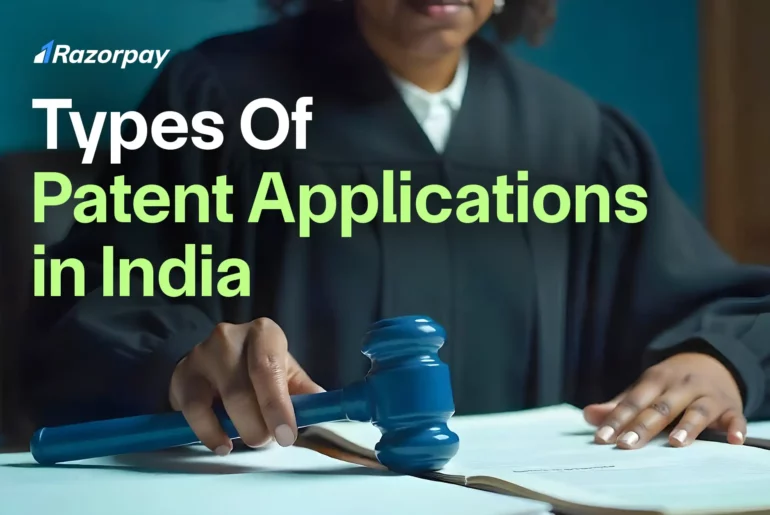Patent application is a formal document that inventors or their representatives submit to a patent office to request legal protection for their inventions or discoveries against unauthorized use, reproduction, and commercial exploitation of their inventions.
Related Read: What is a patent?
Table of Contents
Types of Patent Applications in India
Here’s the list of the various types of patent applications in India:
- Ordinary Application
- Convention Application
- PCT International Application
- PCT National Phase Application
- Patent of Addition
- Divisional Application
1. Ordinary or Non-Provisional Application
- An ordinary (or non-provisional) patent application is filed when an invention is fully developed.
- It contains detailed specifications of the invention’s structure, function, and unique features, along with claims defining the scope of legal protection.
- It is submitted with a complete specification.
- Once approved, it provides full legal protection, granting the inventor exclusive rights to make, use, sell, or license the invention.
- This type of application is immediately examined by the patent office and must meet all patentability requirements to secure enforceable patent rights.
2. Convention Application
- A convention application allows you to claim the priority date of a similar patent application filed in a convention country.
- You should file this application if you’ve already submitted a patent application in a convention country and wish to protect your invention in India.
- To file this application, you must do so within 12 months of the initial filing in the convention country.
- The key advantage of a convention application is that it helps maintain the priority date, ensuring that your invention is protected across multiple jurisdictions.
3. PCT International Application
- A PCT International Application is filed under the Patent Cooperation Treaty (PCT), allowing you to seek patent protection in over 150 member countries with a single filing.
- You should file this application if you intend to protect your invention in multiple countries.
- The requirements include filing through the Indian Patent Office as a receiving office, along with the necessary forms and fees.
- The key advantage is a simplified process for international patent protection, providing more time to evaluate your invention’s potential in different markets.
4. PCT National Phase Application
- A PCT National Phase Application is a formal request to secure patent protection in specific countries based on a single international patent application filed under the Patent Cooperation Treaty (PCT).
- This application must be submitted within 31 months from the international filing date or the priority date, whichever is earlier.
- To file, you need to complete the national phase entry by submitting the required forms and fees for each designated country.
- The benefit of this application is that it helps you protect your invention in the countries you choose. This means that in those countries, you have legal rights to your invention, so others can’t use, sell, or make it without your permission.
5. Patent of Addition
- A Patent of Addition enables applicants and patentees to apply for an improvement or modification made on the invention disclosed in the complete specification. The improvement must be more than a mere workshop improvement.
- A Patent of Addition is filed when you have an improvement or modification to an existing patented invention.
- You should file this application if your changes to the invention are new and significant.
- To file this application, you must reference the original patent and demonstrate how the new improvement or modification enhances it.
- The key advantage of a Patent of Addition is that it does not require a separate renewal fee, and it expires along with the main patent.
6. Divisional Application
- Filing divisional applications is a strategic approach to protect different inventions disclosed in a single original application, ensuring that each invention is examined and protected separately.
- A divisional application is filed when an original patent application claims more than one invention.
- You should file this application if your initial filing covers multiple distinct inventions and you want to separate them into individual applications.
- The divisional application must originate from the parent application, retaining the same priority date.
- The advantage of filing divisional applications is that it ensures each invention receives individual protection while maintaining the original filing date for all applications, maximizing the value of your intellectual property.
Related Read: How to Apply and File a Patent in India in 2025?
How to Choose the Right Patent Application?
Follow these steps to ensure you make an informed decision:
1. Understand Your Invention’s Status
- Fully Developed: If your invention is complete, consider filing a non-provisional application.
- In Development: If your invention is not yet fully realized, opt for a provisional application to secure an early filing date.
2. Identify the Type of Protection Needed
- Scope: Decide if you need comprehensive legal protection or temporary rights.
- Geographic Reach: Consider if you want protection in multiple countries or just domestically.
3. Consider the Different Types of Patent Applications
- Provisional Application: Ideal for inventions still in development; provides early protection.
- Non-Provisional Application: Suitable for fully realized inventions to claim full patent rights.
- Convention Application: Use this if you’ve filed in a convention country and want to claim the same priority date in another country.
- PCT International Application: Best for seeking protection in multiple countries with a single filing.
- PCT National Phase Application: For securing rights in specific countries after filing a PCT application.
- Patent of Addition: File for significant improvements to an existing patent without separate renewal fees.
- Divisional Application: Appropriate for filing separately when your original application contains multiple inventions.
4. Choose the Right Patent Filing Basis
- Select the Appropriate Basis: Consider whether to file for a utility, design, or provisional patent.
- Utility Patent: Offers broader protection for functional aspects.
- Design Patent: Focuses on ornamental aspects.
- Filing Under the Wrong Basis: Be aware that this could limit your coverage and leave elements unprotected.
5. Evaluate Novelty and Non-obviousness
- Novelty Requirement: Ensure your invention is new and has not been previously disclosed.
- Non-obviousness Assessment: Check that your invention isn’t an obvious improvement to someone skilled in the field.
6. Conduct Preliminary Searches
- Perform Patent Searches: Check if similar inventions exist using tools like Google Patents or Espacenet.
- Identify Prior Art: This helps guide your choice of application type and refines your claims.
7. Consult a Patent Attorney or Agent
- Seek Professional Advice: Consult a patent professional for guidance tailored to your situation.
- Drafting Assistance: They can help draft a robust application and navigate the filing process.
8. Review Your Timeline and Budget
- Time Allocation: Determine how much time you can invest in the application process.
- Cost Considerations: Be aware of the costs associated with different application types and filing fees in various jurisdictions.
9. Prepare the Necessary Documentation
- Gather Required Documents: Ensure you have all necessary materials ready, including specifications, claims, and drawings.
- Drafting Quality: A well-prepared application enhances your chances of securing a patent.
10. Maintain the Integrity of Your Patent
- Integrity and Validity: Ensure the chosen filing basis aligns with your invention to maintain patent integrity.
- Examination Process Influence: Be mindful that incorrect basis selection can lead to examination challenges, risking rejection or limited scope.
- Alignment with Invention: Make sure your application clearly communicates your invention’s unique aspects for a successful application process.
Conclusion
Understanding patent applications in India is vital for protecting your invention. Choose the right type (provisional, divisional, etc.) to suit your needs. Accurate documentation and timely filing are crucial for securing exclusive rights and maximizing market benefits.
Frequently Asked Question
1. What are the 4 parts of a patent application?
The four main parts of a patent application, as per The Patents Act, 1970, are:
- Title: A clear and descriptive title indicating the subject matter of the invention.
- Description: A detailed account of the invention, including its operation or use and the best method of performing it.
- Claims: One or more claims defining the scope of the invention for which protection is sought.
- Abstract: A summary providing technical information about the invention.
2. What are the most common patent applications filed?
The most common patent applications filed during the reporting year 2022-23 were in computer science, electronics, communication, mechanical, and electrical inventions.
3. How many forms are there in patent applications?
There are 34 forms related to patent applications. These forms cover various processes, including applications for patents, amendments, requests for examinations, oppositions, and more.
4. How many patent applications are granted?
During the year 2022-23, a total of 34,134 patent applications were granted , reflecting a robust engagement with intellectual property rights and a significant number of innovations recognised and protected.
5. Which types of patent applications are most suitable for my invention or design?
Choose a provisional patent application for early protection while you develop your invention. Opt for a complete patent application if your invention is fully developed and ready for disclosure. Use a design patent application to protect the ornamental design of a functional item. Select based on your invention’s stage and protection needs.
6. How does a provisional application differ from a non-provisional application?
A provisional application offers an early filing date and ‘patent pending’ status without needing a formal claim or detailed description. A non-provisional application requires a full description, claims, and drawings and starts the examination process. You must file the non-provisional application within 12 months of the provisional one to keep the earlier filing date.
7. What is the process for filing different types of patent applications?
The process for filing different types of patent applications involves preparing the necessary documentation, selecting the appropriate type of application, and submitting it to the relevant patent office. Additional steps, such as international filings or divisional applications, may be required for specific types.


